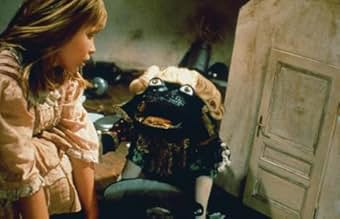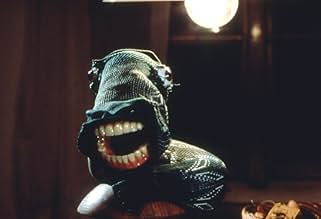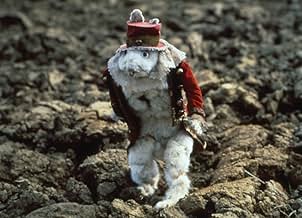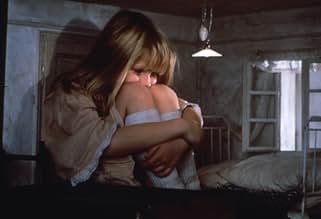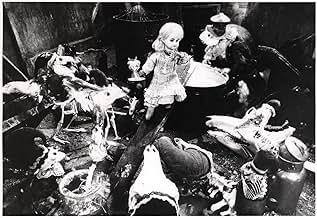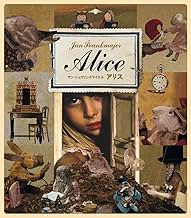NOTE IMDb
7,4/10
15 k
MA NOTE
Alice au pays des merveilles revisité de manière surréaliste.Alice au pays des merveilles revisité de manière surréaliste.Alice au pays des merveilles revisité de manière surréaliste.
- Réalisation
- Scénario
- Casting principal
- Récompenses
- 1 victoire et 1 nomination au total
Camilla Power
- Alice
- (English version)
- (voix)
Avis à la une
A mix of live action and stop-action, this arthouse flick is intriguing but bizarre. But if I was a little kid I'd be scared out of my wits by The White Rabbit with bulging glass eyeballs & long, hamster-like fangs. Socks become wood-eating worms, Alice starts eating marmalade full of tacks, a tiny mouse lands on her head, punctures it & starts a fire, the rabbit hole she falls down starts as a desk drawer that grabs her & draws her in. The Alice doll she becomes when she's shrunk is sweet but sad. I have to admit it's fascinating and 180 degrees from the saccharine sweetness of the Disney film. See it on video to experience something completely different, and probably more towards the way Lewis Carroll intended the story to be...
How best to interpret such a well-known classic in movie terms? Well, Jan Svankmajer, clearly an artist himself (a Czech version of Peter Greenaway) does it by extracting the essence of the book; the black humour and droll critique of Victorian society, investing it with his own rich surrealistic imagery. (Disney is not in the picture!)
Alice, played by a beautiful, doll-like girl, is energetic, brave and simple-minded, while her surroundings gradually go bonkers in ritual displays of nonsensical social custom. Svankmajer's celebrated mastery of dolls is on superb display, and dead objects, mostly worn, tattered and grotesquely animated, take on nightmarish properties. Foodstuffs certainly look repellent when sliding noisily across the kitchen-table!
The start of the movie is classic Svankmajer: Alice lies on the floor of her room, idly throwing pebbles into a half-empty tea-cup. (seen as a series of hypnotically repeated actions). The White Rabbit, here a stuffed specimen inside a glass display-cage, suddenly comes to life, puts on clothing hidden under the floor of his cage, cuts the wires that fasten his feet to the floor, breaks the glass, and he's off!
Svankmajer's "Alice" is the only version that comes close to rendering what Lewis Carroll's book is all about. It's a top notch art-movie for discerning audiences.
Alice, played by a beautiful, doll-like girl, is energetic, brave and simple-minded, while her surroundings gradually go bonkers in ritual displays of nonsensical social custom. Svankmajer's celebrated mastery of dolls is on superb display, and dead objects, mostly worn, tattered and grotesquely animated, take on nightmarish properties. Foodstuffs certainly look repellent when sliding noisily across the kitchen-table!
The start of the movie is classic Svankmajer: Alice lies on the floor of her room, idly throwing pebbles into a half-empty tea-cup. (seen as a series of hypnotically repeated actions). The White Rabbit, here a stuffed specimen inside a glass display-cage, suddenly comes to life, puts on clothing hidden under the floor of his cage, cuts the wires that fasten his feet to the floor, breaks the glass, and he's off!
Svankmajer's "Alice" is the only version that comes close to rendering what Lewis Carroll's book is all about. It's a top notch art-movie for discerning audiences.
The Alice books are one of the two richest works of literature yet produced. Of the best literature, Alice lends itself to cinematic reinterpretation. And this filmmaker has vision.
But Alice is a coherent work, following the 'apprentice' novel and having kabbalistic structure. This film is episodic, each episode conceived as a different world, connected only by doors. The stories establish an abstract world, a world of logic so pure that the weaknesses of logic are apparent. That's only in part attempted here.
Though in Czech, there is some dainty wordplay: Alice is messing about in her drawers. Initially, these contain drawing equipment, later scissors. The filmmakers' signature 'large person in small room' image is used here in the episode where 'Maryanne' (Alice plus her 'house) is attempted entry by Bill the lizard, Dodgson's image of sperm. Bill is mirrored later in the frog-footman, heavily phallic as is an introduced sequence where the feet themselves become penile, then advisory.
Svenkmajer understands the cards as Tarot, a seldom understood insight and adds a vignette of the March Hare and Hatter playing cards (almost certainly a nod to 'Seventh Seal'). There's some very good visual handling of inside/outside ambiguities, and stage/reality shifting -- this alone makes this project worth sharing. But aside from that, it seems that the magic of Alice's world has yet to be tapped by a filmmaker.
Note: in Carroll's vision, innocence trumps all: logic is seen as manmade and fallible. In this world confabulated reasoning threatens but no one really loses their head. Not so in Svenkmajer's bleak world. Heads really are lost. Innocence is at least dumbfounded and possibly unreal (those socks). Many heads are already decayed with only the skull remaining. Some beings are composed of empty skulls alone or with some ambulatory object. This is not a happy man, nor a world with any sunshine. I would not give these images to any child.
But Alice is a coherent work, following the 'apprentice' novel and having kabbalistic structure. This film is episodic, each episode conceived as a different world, connected only by doors. The stories establish an abstract world, a world of logic so pure that the weaknesses of logic are apparent. That's only in part attempted here.
Though in Czech, there is some dainty wordplay: Alice is messing about in her drawers. Initially, these contain drawing equipment, later scissors. The filmmakers' signature 'large person in small room' image is used here in the episode where 'Maryanne' (Alice plus her 'house) is attempted entry by Bill the lizard, Dodgson's image of sperm. Bill is mirrored later in the frog-footman, heavily phallic as is an introduced sequence where the feet themselves become penile, then advisory.
Svenkmajer understands the cards as Tarot, a seldom understood insight and adds a vignette of the March Hare and Hatter playing cards (almost certainly a nod to 'Seventh Seal'). There's some very good visual handling of inside/outside ambiguities, and stage/reality shifting -- this alone makes this project worth sharing. But aside from that, it seems that the magic of Alice's world has yet to be tapped by a filmmaker.
Note: in Carroll's vision, innocence trumps all: logic is seen as manmade and fallible. In this world confabulated reasoning threatens but no one really loses their head. Not so in Svenkmajer's bleak world. Heads really are lost. Innocence is at least dumbfounded and possibly unreal (those socks). Many heads are already decayed with only the skull remaining. Some beings are composed of empty skulls alone or with some ambulatory object. This is not a happy man, nor a world with any sunshine. I would not give these images to any child.
This movie may be labeled frustratingly plotless by some, and that's fair, but the imagery in this strange combination of stop-motion animation and live footage is so hauntingly rich and evocative that you get the feeling that someone has secretly filmed your own childhood dreams and translated them into Czech - perhaps for the viewing pleasure of the former commissars. The basic idea is that all of ALICE IN WONDERLAND is occurring in Alice's house, and a staggering variety of household items are animated into jerky sort of life, while all the character voices - Mad Hatter, Queen of Hearts, White Rabbit - are spoken by Alice. Alice's house, however, is a Czech house, and the items are old even by Soviet bloc standards. It's as if an antique rummage sale suddenly sprang to life to act out a monstrous little comedy for one girl. And the architecture is simultaneously comforting and frightening. Windows, for example, merely open onto other rooms, all lit by bare light bulbs. What keeps the thing tied to Lewis Carroll is the performance of the little girl playing Alice. She appears to be about six or seven, and despite the disturbing events going on around her, she never appears frightened, and always investigates events as they grow curiouser and curiouser with a determined pluck. This little girl is always in control. What this adaptation lacks in forward momentum or narrative drive it makes up for with a surreal poetry of the domestic space as dreamed by a child.
This film mixes the live action of just one actress - Alice - with a ghoulish array of stop-motion animated characters and objects. Whereas Lewis Carroll's original "Alice in Wonderland" story is a celebration of childhood innocence, fantasy, and magical belief, Svankmajer's "Alice" tells the reverse - the loss of childhood innocence through the pain of coming to terms with a less-than magical world. Inspired by the original tale, Svankmajer uses Carroll's idea of a childishly implausible and wild dream to symbolise an escape from a tormented childhood, rather than a daydreaming fantasy in the sun.
With very little dialogue at all, Alice's job as an actress is restricted entirely to responding appropriately to the puppets - which involves no more than recoiling or widening her eyes. This takes nothing away from the film, however; Alice's muteness is a reflection of the classic "children should be seen and not heard" oppressive school of parenting. Indeed, Alice is seen throughout the film to, despite the hellish surroundings, still wipe her feet on doormats, remove her shoes before entering rooms, and do as she is told. She has been brought up through a harsh discipline that keeps her mute, polite, under control and unquestioning - indeed the very first scene of the film shows her older sister wordlessly slap her for being curious as to the contents of a book. This oppressive discipline is part of what makes up Alice's dismal reality, and hence is part of what she is both trying to escape and rebel from by dreaming.
The sad result is that even Alice's dreams are tormented. Children can only dream about the things presented to them in reality. In the first scenes of the film, the camera pans across Alice's room and displays all the junk carelessly surrounding her - a keen viewer will notice that these are the very same objects that Svankmajer later animates inside Alice's dream. It is precisely because Alice's real world is so abysmal that her dream reflects it. Her house seems devoid of life - we never see any parents, and the sister is still out by the riverside - and the house itself is claustrophobic, dark and utterly unfit for human habitation. The ornaments are stuffed bugs, the only visible food is being pickled in tightly clasped jars, and every single surface is smothered in brown grime. The lack of any other life in the house and the lack of any form of homely care, all depict a tragedy of childhood neglect - Svankmajer blames the nightmare entirely on the parents.
Within her dream, Alice suddenly finds that her room expands outwards into an endless muddy plain. This expanse, a dream of freedom, is tragically desolate and uninviting. Nevertheless, she follows one of her now-animated "toys" (the white rabbit) out into the field. Over the course of the film she will meet with a sailing rat, a truly insane depiction of the Mad Hatter and March Hare, and the murderous Queen of Hearts. But ultimately these are only the dream-animated versions of toys Alice detests. The truly sinister characters in her dream are those that come directly from her house, her life. The pickled jars of food turn out to be mixed with drawing pins, the "Drink Me" and "Eat Me" potions and cakes are bottles of ink and nondescript tarts, a mousetrap spells the demise of the sailing rat; when left on her own in a room, its contents attack her - slabs of meat slither around, bread turns to a porcupine of nails, food cans turn out to contain the stuffed beetles used as ornaments in her house (now living).
It is in this scene that Alice first starts to experience some symbolic victory. Throughout the film we see Alice begin to show more curiosity, begin to learn, begin to rebel against what she is told to do, and begin - most importantly - to come to terms with her surroundings. She is ultimately locked away in a dark room - the culmination of all the negative forces around her - trapped inside a doll of herself. Nothing could be more symbolic of the repressive upbringing that has spawned this twisted dream. She has realised that she's been made into a doll - inhuman. It is with this realisation that Alice achieves her first rebellion, tearing her way out of the doll and - through unhindered curiosity - discovers the key to leave the room by.
We are constantly reminded that the dream is a learning process for Alice. Every single time there is dialogue within the film, we immediately see Alice's lips say the words "...the March Hare said", or "...Alice thought to herself". These metatextual scenes suggest Alice is fully aware that this is all a story of her own imaginings. At bare minimum, it suggests that Alice has a level of awareness that oversees the story as a whole - she is looking upon these events with some purpose.
Alice wakes from her dream a changed person. She has grown up the hard way - her last vain attempt at a childish fantasy built from her sordid life has led her to come to terms with how reality really is. She has learnt that we cannot be mute and polite little girls - the world will attack us, and we must defend ourselves. It's a sorry world-view she ends up with, but one necessary for her to be able to live in the neglected environment she's been brought up in. Thus the film ends with her own decision and dialogue - "the rabbit is late again" - she snaps a pair of scissors - "perhaps I'll cut his head off".
Svankmajer's "Alice" is a masterpiece of stop-motion animation. Puppets come terrifyingly to life, and the surreal dream Alice undergoes is an intensely striking barrage of disturbing images. It is no film for children.
With very little dialogue at all, Alice's job as an actress is restricted entirely to responding appropriately to the puppets - which involves no more than recoiling or widening her eyes. This takes nothing away from the film, however; Alice's muteness is a reflection of the classic "children should be seen and not heard" oppressive school of parenting. Indeed, Alice is seen throughout the film to, despite the hellish surroundings, still wipe her feet on doormats, remove her shoes before entering rooms, and do as she is told. She has been brought up through a harsh discipline that keeps her mute, polite, under control and unquestioning - indeed the very first scene of the film shows her older sister wordlessly slap her for being curious as to the contents of a book. This oppressive discipline is part of what makes up Alice's dismal reality, and hence is part of what she is both trying to escape and rebel from by dreaming.
The sad result is that even Alice's dreams are tormented. Children can only dream about the things presented to them in reality. In the first scenes of the film, the camera pans across Alice's room and displays all the junk carelessly surrounding her - a keen viewer will notice that these are the very same objects that Svankmajer later animates inside Alice's dream. It is precisely because Alice's real world is so abysmal that her dream reflects it. Her house seems devoid of life - we never see any parents, and the sister is still out by the riverside - and the house itself is claustrophobic, dark and utterly unfit for human habitation. The ornaments are stuffed bugs, the only visible food is being pickled in tightly clasped jars, and every single surface is smothered in brown grime. The lack of any other life in the house and the lack of any form of homely care, all depict a tragedy of childhood neglect - Svankmajer blames the nightmare entirely on the parents.
Within her dream, Alice suddenly finds that her room expands outwards into an endless muddy plain. This expanse, a dream of freedom, is tragically desolate and uninviting. Nevertheless, she follows one of her now-animated "toys" (the white rabbit) out into the field. Over the course of the film she will meet with a sailing rat, a truly insane depiction of the Mad Hatter and March Hare, and the murderous Queen of Hearts. But ultimately these are only the dream-animated versions of toys Alice detests. The truly sinister characters in her dream are those that come directly from her house, her life. The pickled jars of food turn out to be mixed with drawing pins, the "Drink Me" and "Eat Me" potions and cakes are bottles of ink and nondescript tarts, a mousetrap spells the demise of the sailing rat; when left on her own in a room, its contents attack her - slabs of meat slither around, bread turns to a porcupine of nails, food cans turn out to contain the stuffed beetles used as ornaments in her house (now living).
It is in this scene that Alice first starts to experience some symbolic victory. Throughout the film we see Alice begin to show more curiosity, begin to learn, begin to rebel against what she is told to do, and begin - most importantly - to come to terms with her surroundings. She is ultimately locked away in a dark room - the culmination of all the negative forces around her - trapped inside a doll of herself. Nothing could be more symbolic of the repressive upbringing that has spawned this twisted dream. She has realised that she's been made into a doll - inhuman. It is with this realisation that Alice achieves her first rebellion, tearing her way out of the doll and - through unhindered curiosity - discovers the key to leave the room by.
We are constantly reminded that the dream is a learning process for Alice. Every single time there is dialogue within the film, we immediately see Alice's lips say the words "...the March Hare said", or "...Alice thought to herself". These metatextual scenes suggest Alice is fully aware that this is all a story of her own imaginings. At bare minimum, it suggests that Alice has a level of awareness that oversees the story as a whole - she is looking upon these events with some purpose.
Alice wakes from her dream a changed person. She has grown up the hard way - her last vain attempt at a childish fantasy built from her sordid life has led her to come to terms with how reality really is. She has learnt that we cannot be mute and polite little girls - the world will attack us, and we must defend ourselves. It's a sorry world-view she ends up with, but one necessary for her to be able to live in the neglected environment she's been brought up in. Thus the film ends with her own decision and dialogue - "the rabbit is late again" - she snaps a pair of scissors - "perhaps I'll cut his head off".
Svankmajer's "Alice" is a masterpiece of stop-motion animation. Puppets come terrifyingly to life, and the surreal dream Alice undergoes is an intensely striking barrage of disturbing images. It is no film for children.
Le saviez-vous
- AnecdotesDirector Jan Svankmajer had been disappointed by other adaptations of Carroll's book, which interpret it as a fairy tale. His aim was instead to make the story play out like an amoral dream.
- GaffesAfter testing the wooden mushroom fragments, Alice puts the piece that shrinks things in her right pocket and the other that enlarges things in the left one. In the next scene she encounters a tiny house and takes out the right hand fragment to enlarge it.
- ConnexionsFeatured in Brows Held High: Alice (2011)
Meilleurs choix
Connectez-vous pour évaluer et suivre la liste de favoris afin de recevoir des recommandations personnalisées
- How long is Alice?Alimenté par Alexa
Détails
- Durée1 heure 26 minutes
- Mixage
- Rapport de forme
- 1.37 : 1
Contribuer à cette page
Suggérer une modification ou ajouter du contenu manquant


